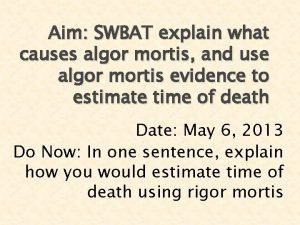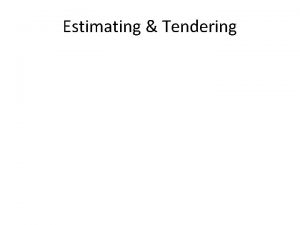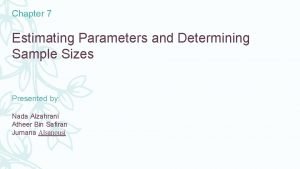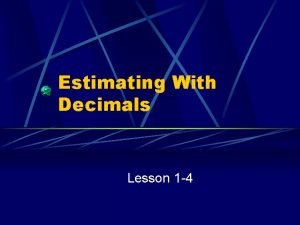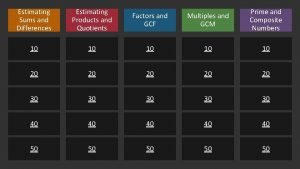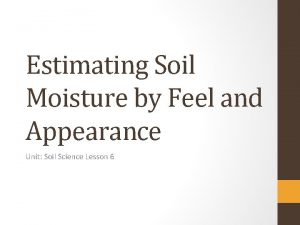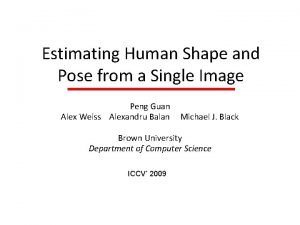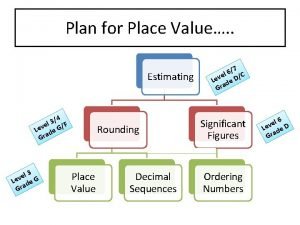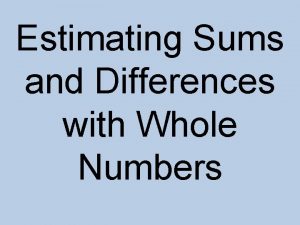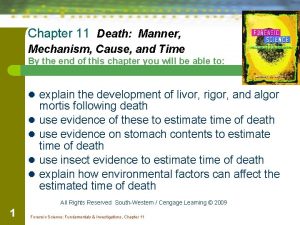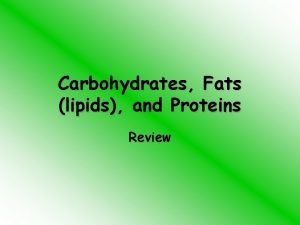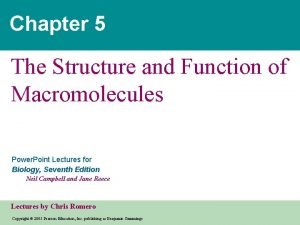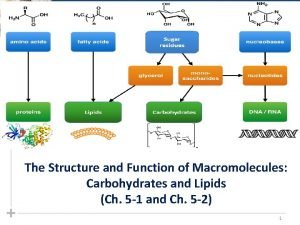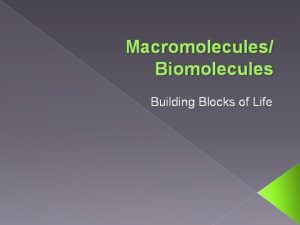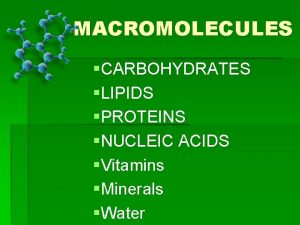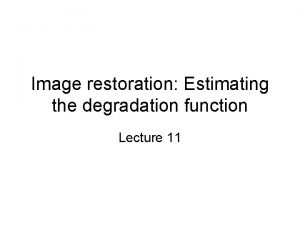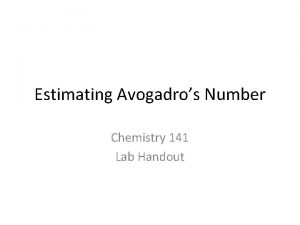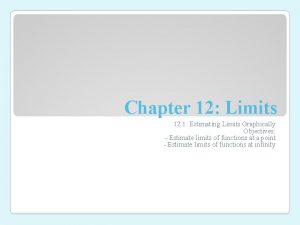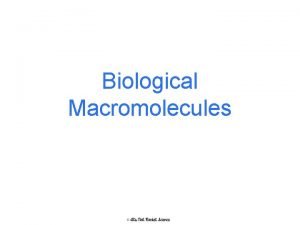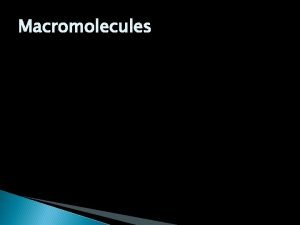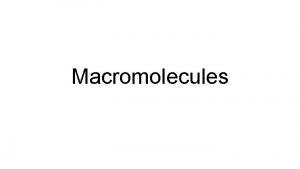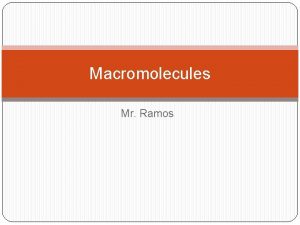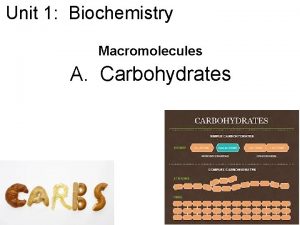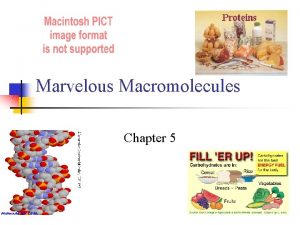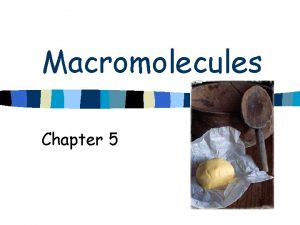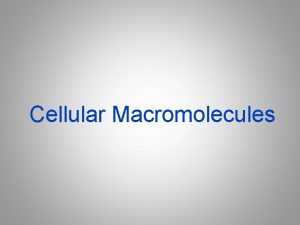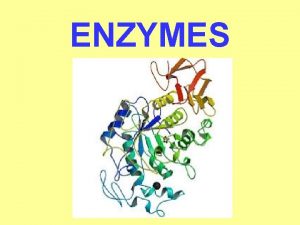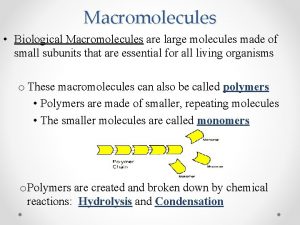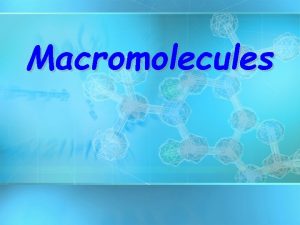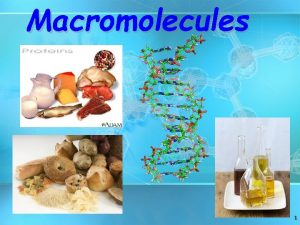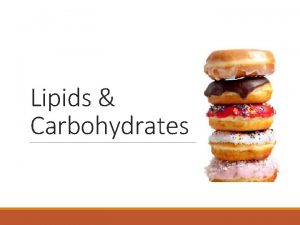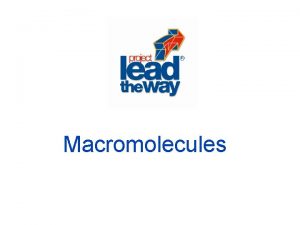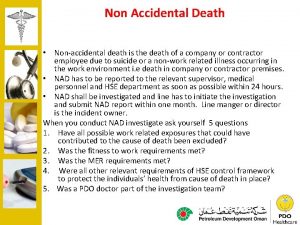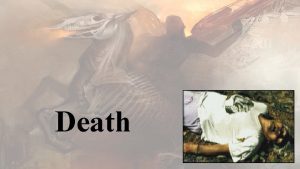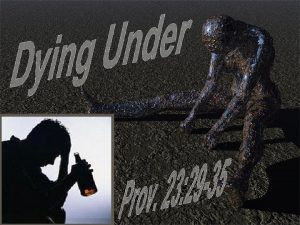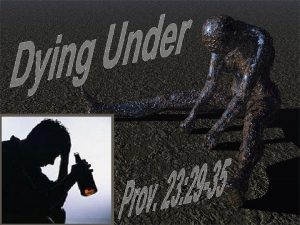Macromolecules and Estimating Time of Death Macromolecules Large










































- Slides: 42

Macromolecules and Estimating Time of Death

Macromolecules Ø _____ Large molecules made from _______ smaller molecules

Monomers vs Polymers One Ø Monomer = _____ Two Ø Polymer = ______ more or _______ Ø E. x

Monomers Building Ø _____ blocks for larger molecules Ø Macromolecules breakdown into ____ monomers

Macromolecules in living things 1. Carbohydrates 2. Lipids 3. Proteins 4. Nucleic Acids

Carbohydrates Function: 1. Energy for cellular processes 2. Structural uses in plants

Simple vs Complex Sugars Monosaccharides Simple sugar l _____ Single l _____ unit of sugar l EX. Polysaccharides Complex sugars l ____ Multiple units of l ____ sugar l EX

Storage of Sugar Ø Plants store sugar as _____ starch Ø Animals store sugar as _____ glycogen Ø Both are considered ______ polymers

Examples of Carbs

Lipids **Insoluble in water Functions: 1. Store energy 2. Insulate body 3. Protect organs 4. Provide waterproof coverings

Monomers of Lipids **Fatty acids are monomers of lipids 1. Saturated fatty acids Solid at room temp l ____ 2. Unsaturated fatty acids Liquid at room temp l _______

Saturated vs Unsaturated Fatty Acids Ø Why are unsaturated fatty acids liquid at room temp? • Carbon tails are loose ______ Why are saturated fatty acids solid at room temp? • Carbon tails are _____ stuck together Ø

Examples of Lipids Wax

Proteins Functions: Ø Control rate of reactions Monomers Ø Amino acids Ø Identified by different R-Group

Examples of Proteins

Nucleic Acids Function: Ø Store and transmit genetic info Made up of Ø Nucleotides

Examples of Nucleic Acids

Identify the Macromolecule

Table Talk 1. Complete the following analogy l 2. Plants: Starch: Animals: ______ Complete the following analogy l Carbohydrates : Monosaccharaides: Proteins: ______ Is galactose classified as a monosaccharide or a polysaccharide? Where is it found? 4. Why are saturated fats liquid at room temperature? 3.

The Stomach Ø Takes _____ 4 -6 hours to empty l Is dependent on What and how much _______ you ate

Ø Muscle Peristalsis contractions that _____ move food through the digestive system.

How Does Food Get From Your Mouth To Your Stomach?

Stomach Contents Can determine: Mode of death Ø _______ Manner of death Ø _______ Estimate the Ø _____ time of death https: //www. youtube. c om/watch? v=8 r. NQM 3 N 26 dw

Four Modes of Death 1. Natural Causes 2. Accidental Death 3. Homicide 4. Suicide

How to Estimate Time of Death 1. More solid particles = l Less time has passed since eating and death 2. More liquid = l More time has passed since eating and death

Who died most recently after eating? B A C

What else can stomach contents reveal? Ø If the person was _____ poisoned Ø If the person used drugs _____

Carbohydrate (Starch) Test

Protein Test

Lipid Test Positive

Sugar Test Negative Positive

Macromolecule Lab Analysis Questions 1. 2. 3. 4. 5. According to your results, which sample contained starch? Look for a color change!! According to your results, which samples contained sugar? Look for a color change!! According to your results, which samples contained proteins? Look for a color change!! According to your results, which samples contained lipids? Bag should be transparent. Based on your knowledge of macromolecules, classify each of the samples you tested as a carbohydrate, a lipid, a protein or a nucleic acid.

Case Study #1 Matt is found dead @ 10 a. m. He is found at a table set for two people. His stomach contents reveal large chunks of chicken, bite size pieces of spaghetti and corn. a) Did he die shortly after eating or a long time after eating? How do you know this? b) Which macromolecule(s) were found in his stomach? How do you know this? c) What was the mode of death? How do you know this? What leads you to think this?

Case Study #2 Will is found dead @ 3 p. m. He was last seen eating a brownie with nuts. His stomach contents reveal a brown liquid and traces of nuts. Will is allergic to nuts. a) Which macromolecule(s) were found in his stomach? How do you know this? b) What is the mode of death? What leads you to think this? c) Did he die shortly after eating or a long time after eating? How do you know this?

Case Study #3 Lindsey was pronounced dead last night, her stomach contents revealed large pieces of bacon, chunks of fat, and a liquid white substance that turned from light blue to purple when tested with Biuret solution. There was a large piece of bacon lodged in her esophagus. a) What was the mode of death? What leads you to think this? b) Which macromolecule(s) were found in her stomach? How do you know this? c) Did she die shortly after eating or a long time after eating? How do you know this?

Case Study #4 Kurt Cobain was found dead last Thursday. His stomach contents revealed a small trace of liquid, both Lugol’s solution and Benedict solution yielded positive results. Witnesses say they saw him eating dinner at The Old Spaghetti Factory the night before, he was mumbling to himself and had been drinking since noon. a) Which macromolecule(s) were found in his stomach? How do you know this? b) Did he die shortly after eating or a long time after eating? How do you know this? c) What was his mode of death? What leads you to think this?

Digestion Ø The _____ breakdown of food 1. Mechanical Digestion 2. Chemical Digestion

Digestive Organs Which organ produces insulin? Ø Which organ stores bile? Ø Which organ transports food from the mouth to the stomach? Ø Where is bile made? Ø What moves food through the digestive system? Ø

Peristalsis and Death Ø Does peristalsis occur after death?

Movement of food Esophagus ____________ Small intestine rectum ____ Ø Mouth Stomach Large Intestine Ø Gall bladder and pancreas l Release substances which are necessary for digestion

He’s full of what? ? ? Been constipated since birth Ø Laxatives allowed somes relief Ø Hischprung’s disease Ø

Organs of the Digestive System Digestive system webquest
 Time of death calculations worksheet
Time of death calculations worksheet Estimating project time and cost
Estimating project time and cost Top down budgeting vs bottom up budgeting
Top down budgeting vs bottom up budgeting Estimating project time and cost
Estimating project time and cost Difference between somatic and molecular death
Difference between somatic and molecular death Start time end time and elapsed time
Start time end time and elapsed time Cost analysis and estimating for engineering and management
Cost analysis and estimating for engineering and management Cost analysis and estimating for engineering and management
Cost analysis and estimating for engineering and management Cost analysis and estimating for engineering and management
Cost analysis and estimating for engineering and management Cost analysis and estimating for engineering and management
Cost analysis and estimating for engineering and management Cost analysis and estimating for engineering and management
Cost analysis and estimating for engineering and management Once upon a time a very large and strong wolf
Once upon a time a very large and strong wolf Rounding and estimating
Rounding and estimating Tendering and estimating
Tendering and estimating Types of electrical engineering
Types of electrical engineering Estimating parameters and determining sample sizes
Estimating parameters and determining sample sizes Agile estimating and planning
Agile estimating and planning What is front-end estimation with decimals
What is front-end estimation with decimals Ground rules earthwork estimating software
Ground rules earthwork estimating software Rounding and estimating decimals
Rounding and estimating decimals Estimate sums and differences of mixed numbers
Estimate sums and differences of mixed numbers Estimating products and quotients
Estimating products and quotients Estimating soil moisture by feel and appearance
Estimating soil moisture by feel and appearance Estimating human shape and pose from a single image
Estimating human shape and pose from a single image Place value and estimating
Place value and estimating Estimating sums and differences of whole numbers
Estimating sums and differences of whole numbers Chapter 11 death meaning manner mechanism cause and time
Chapter 11 death meaning manner mechanism cause and time Micromolecules and macromolecules
Micromolecules and macromolecules What macromolecules are in bread olive oil and pasta
What macromolecules are in bread olive oil and pasta Chapter 5 the structure and function of macromolecules
Chapter 5 the structure and function of macromolecules Carbohydrates
Carbohydrates Monomers building blocks
Monomers building blocks Are vitamins and minerals macromolecules
Are vitamins and minerals macromolecules Types of information system
Types of information system Usace cost estimating software
Usace cost estimating software Estimation of degradation function
Estimation of degradation function Shruti sheladia
Shruti sheladia Dr nabil khouri
Dr nabil khouri 1 cubic yard of concrete weight
1 cubic yard of concrete weight Estimating avogadro's number lab
Estimating avogadro's number lab 12-1 estimating limits graphically
12-1 estimating limits graphically Estimating with percents
Estimating with percents Estimating limit values from tables
Estimating limit values from tables
